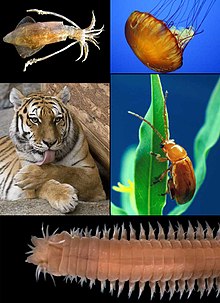Planulozoa
Planulozoa| Planulozoa 시간 범위: Ediacaran–Recent PreꞒ Ꞓ OSDCPTJKPg N. | |
|---|---|
 | |
| planulozoans의 다양성 | |
| 과학적 분류 | |
| 킹덤: | |
| Subkingdom: | |
| (unranked): | |
| (unranked): | Planulozoa Wallberg(알., 2004년 |
| Phyla | |
| Bilateria/Triploblasts(unranked)
| |
그 판형 동물문의 여동생은으로 Planulozoa은 제안된 기저 ParaHoxozoa clade지만 원래 판형 동물문이 포함되어 있다.[1][2] 후자의 경우 Parahoxozoa에 Planulozoa 고위 동의어다. 그것은 자포 동물문(바다 말미잘, 해파리)과 좌우 대칭 동물(편형 동물류, 곤충들과 척추 동물 등은 좀 더 복잡한 동물들)을 포함하고 있다. Cnidaria[3][4][5][6]의 판형 동물문이 될 수 있다는 누나나 더 전통적으로 Planulozoa.[7] 그 clade은 유즐(빗 해파리)[8][9][2]고 해면(해면 갯솜) 같은 기저 동물들을 배제한다.[10][11][12]
(mya)은 혈통 분열 그 계통수년의 약 몇 백만 전을 나타낸다. 여기, Planulozoa sans 털납작 벌레 나와 있다.[13][14][15]
Planulozoa은 Zoc는 마법사와 ZF-NC 유전자 도메인의 밖과 관련되어 있다.[16]
| 초아노조아 |
| ||||||||||||||||||||||||||||||||||||||||||||||||||||||
| 950 mya |
참조
- ^ Edgecombe, G. D.; Giribet, G. (2019-01-15), "Perspectives in Animal Phylogeny and Evolution": A decade later, University of Padova Press, ISBN 9788869381409, retrieved 2019-07-17
- ^ a b Andreas Wallberg; Mikael Thollesson; James S. Farris; Ulf Jondelius (2004). "The phylogenetic position of the comb jellies (Ctenophora) and the importance of taxonomic sampling". Cladistics. 20 (6): 558–578. doi:10.1111/j.1096-0031.2004.00041.x. S2CID 86185156.
- ^ Aleshin, V. V.; Petrov, N. B. (2002). "Molecular evidence of regression in evolution of metazoa". Zh Obshch Biol. 63 (3): 195–208. PMID 12070939.
- ^ Laumer, Christopher E.; Gruber-Vodicka, Harald; Hadfield, Michael G.; Pearse, Vicki B.; Riesgo, Ana; Marioni, John C.; Giribet, Gonzalo (2018-10-30). "Support for a clade of Placozoa and Cnidaria in genes with minimal compositional bias". eLife. 7. doi:10.7554/elife.36278. ISSN 2050-084X. PMC 6277202. PMID 30373720.
- ^ Schuchert, Peter (1993-03-01). "Trichoplax adhaerens (Phylum Placozoa) has Cells that React with Antibodies Against the Neuropeptide RFamide". Acta Zoologica. 74 (2): 115–117. doi:10.1111/j.1463-6395.1993.tb01227.x.
- ^ Syed, Tareq; Schierwater, Bernd (2002-06-01). "The evolution of the placozoa: A new morphological model". Senckenbergiana Lethaea. 82 (1): 315–324. doi:10.1007/bf03043791. ISSN 0037-2110. S2CID 16870420.
- ^ Eitel, Michael; Francis, Warren; Osigus, Hans-Jürgen; Krebs, Stefan; Vargas, Sergio; Blum, Helmut; Williams, Gray Argust; Schierwater, Bernd; Wörheide, Gert (2017-10-13). "A taxogenomics approach uncovers a new genus in the phylum Placozoa". bioRxiv: 202119. doi:10.1101/202119.
- ^ Andreas Hejnol & Mark Q. Martindale (2008). "Acoel development supports a simple planula-like urbilaterian". Philosophical Transactions of the Royal Society B. 363 (1496): 1493–1501. doi:10.1098/rstb.2007.2239. PMC 2614228. PMID 18192185.
- ^ Jaume Baguñà; Pere Martinez; Jordi Paps; Marta Riutort (2008). "Back in time: a new systematic proposal for the Bilateria". Philosophical Transactions of the Royal Society B. 363 (1496): 1481–1491. doi:10.1098/rstb.2007.2238. PMC 2615819. PMID 18192186.
- ^ Whelan, Nathan V.; Kocot, Kevin M.; Moroz, Tatiana P.; Mukherjee, Krishanu; Williams, Peter; Paulay, Gustav; Moroz, Leonid L.; Halanych, Kenneth M. (2017-10-09). "Ctenophore relationships and their placement as the sister group to all other animals". Nature Ecology & Evolution. 1 (11): 1737–1746. doi:10.1038/s41559-017-0331-3. ISSN 2397-334X. PMC 5664179. PMID 28993654.
- ^ C. Borchiellini; M. Manuel; E. Alivon; N. Boury-Esnault; J. Vacelet; Y. Le Parco (2001). "Sponge paraphyly and the origin of Metazoa". Journal of Evolutionary Biology. 14 (1): 171–179. doi:10.1046/j.1420-9101.2001.00244.x. PMID 29280585.
- ^ Pisani, Davide; Pett, Walker; Dohrmann, Martin; Feuda, Roberto; Rota-Stabelli, Omar; Philippe, Hervé; Lartillot, Nicolas; Wörheide, Gert (2015-12-01). "Genomic data do not support comb jellies as the sister group to all other animals". Proceedings of the National Academy of Sciences. 112 (50): 15402–15407. Bibcode:2015PNAS..11215402P. doi:10.1073/pnas.1518127112. PMC 4687580. PMID 26621703.
- ^ Peterson, Kevin J.; Cotton, James A.; Gehling, James G.; Pisani, Davide (27 April 2008). "The Ediacaran emergence of bilaterians: congruence between the genetic and the geological fossil records". Philosophical Transactions of the Royal Society of London B: Biological Sciences. 363 (1496): 1435–1443. doi:10.1098/rstb.2007.2233. PMC 2614224. PMID 18192191.
- ^ Laura Wegener Parfrey; Daniel J G Lahr; Andrew H Knoll; Laura A Katz (16 August 2011). "Estimating the timing of early eukaryotic diversification with multigene molecular clocks" (PDF). Proceedings of the National Academy of Sciences of the United States of America. 108 (33): 13624–9. Bibcode:2011PNAS..10813624P. doi:10.1073/PNAS.1110633108. ISSN 0027-8424. PMC 3158185. PMID 21810989. Wikidata Q24614721.
- ^ "Raising the Standard in Fossil Calibration". Fossil Calibration Database. Retrieved 3 March 2018.
- ^ Layden, Michael J. (2018), "Cnidarian Zic Genes", Zic family, Advances in Experimental Medicine and Biology, vol. 1046, Springer, Singapore, pp. 27–39, doi:10.1007/978-981-10-7311-3_2, ISBN 9789811073106, PMID 29442315





